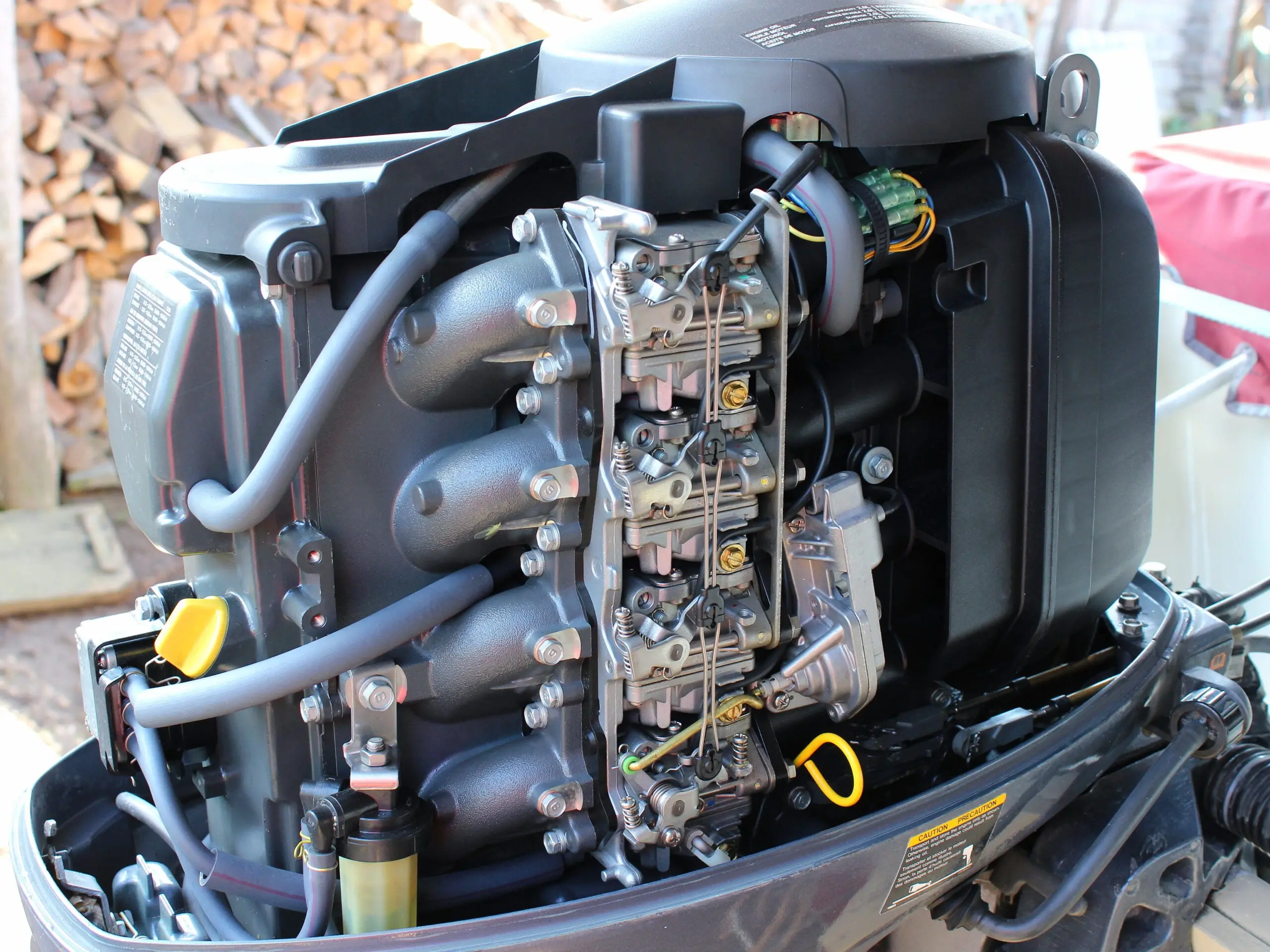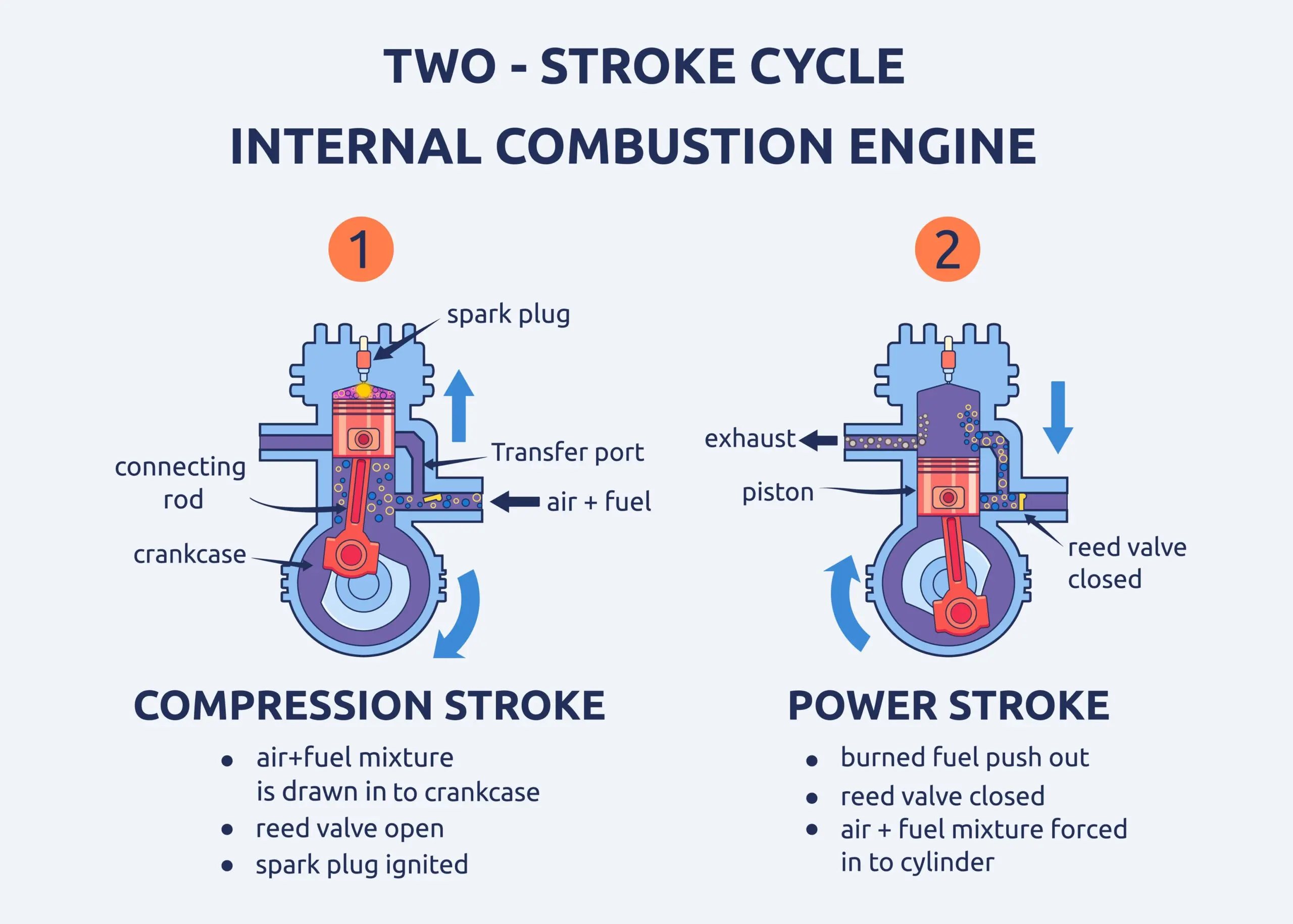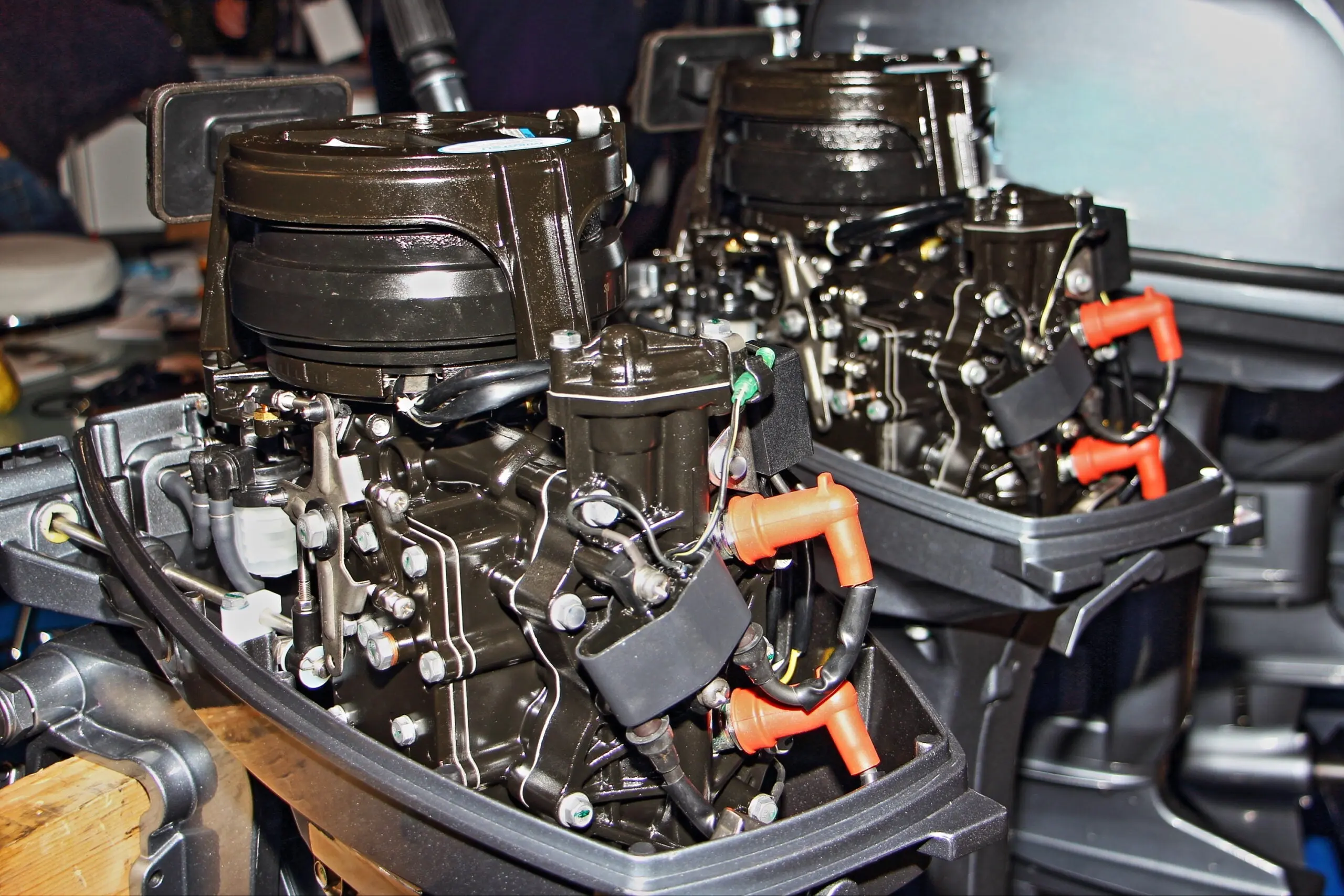_We may earn revenue from the products available on this page and participate in affiliate programs. Learn more ›
_
Years ago, the choice was clear: When it came to 2 stroke vs 4 stroke outboard motors, 2 stroke won every time. Two stroke motors offered a better power-to-weight ratio, were cheaper to manufacture, and easier to maintain. Today, advancements in engine tech and environmental regulations have made the gap between 2 stroke and 4 stroke motors smaller. But there are still merits and drawbacks to each type. Here’s what you need to know about the 2 stroke vs 4 stroke question in order to choose the best outboard motor for your boat.
Outboard Motor Basic Comparison
There are two basic differences between 2 stroke and 4 stroke motors. One has to do with how many strokes it takes a piston to complete an engine cycle (more on that below). The other has to do with how each engine type is configured and lubricated. As the name implies, a 4 stroke engine’s pistons need to move up and down four times to turn the engine once. On 2 stroke engines, the pistons complete the same action in two “strokes.”

A modern 4-stroke outboard motor with the bonnet removed. Ilya / Adobe Stock
As for lubrication, the fuel and air coming into a 2 stroke will contact all internal components of the engine. Because of this, you need to mix oil (the lubricant) with fuel before putting it in a 2 stroke engine—otherwise, the engine will seize up. In a 4 stroke engine, air and fuel (and the combustion of said air and fuel) contact the cylinder only. All of the other metal parts in a 4 stroke are contained separately and are continuously bathed in oil via a reservoir that gets changed every 100 hours or so. If oil changes sound familiar, it’s probably because your car’s gas-powered engine is a 4 stroke.
What is a “Stroke” Exactly?
Engine blocks are made with cylinders (or chambers) to contain explosions (technically they’re not explosions, but it’s easiest here to describe them that way). Those explosions—caused by igniting compressed gasoline and air—push pistons through the cylinders, much like an exploding powder charge pushes a bullet from a rifle barrel. The pistons are attached to a connecting rod, which is connected to the crankshaft, which turns the engine and the propellor on your outboard. The cycle of an engine
is broken up into these steps:
Intake: Air and fuel are brought into the engine.
Compression: The air and fuel mixture is compressed into a tighter space.
Combustion: A spark ignites the compressed air and fuel mixture.
Exhaust: Gasses from the ignited mixture escape from the engine.
With each of these actions, a piston will go up and down within the cylinder, bringing in air and fuel, compressing the mixture, expelling exhaust, and turning the crankshaft. When the piston is at the top of the cylinder the position is called “Top Dead Center (TDC).” When it’s at the bottom it’s called “Bottom Dead Center (BDC).” A “stroke” is when the piston moves from TDC to BDC. The entire process is called a “combustion cycle.” On a 4 stroke, the piston will travel from TDC to BDC four times to turn the crankshaft one time around during a combustion cycle. On a 2 stroke, the piston will travel two times to do the same thing.
A Closer Look at 4 Stroke Engines

This is how a 4-stroke engine works. fauzan / Adobe Stock
4 Stroke Pros
More efficient than a 2 stroke
Quieter than a 2 stroke
No need to mix fuel and oil
4 Stroke Cons
Weighs around 15 percent more than a 2 stroke
More complex in terms of maintenance
As described above, a 4 stroke engine only uses the area above the piston to combust air and fuel and expel exhaust. The combustion cycle starts with the piston going down during intake, bringing oxygen and fuel into the cylinder through a valve (stroke one). Then it goes up, compressing the mixture (stroke two). A spark from a spark plug ignites the mixture, forcing the piston back down (stroke three). Then the piston pushes upward to force the exhaust out of the cylinder through another valve, completing the cycle and turning the crankshaft one revolution (stroke four).
On 4 stroke engines, fuel, air, and exhaust will only enter and exit through valves at the top of the cylinder. These valves, and the mechanism to make sure they open and close properly, are not present on 2 stroke engines. Four strokes also hold an oil reservoir to continuously lubricate the crankshaft and all other internal metal parts. This all adds weight and bulk, as well as more chances for something to go wrong.
But 4 strokes are quieter and more fuel-efficient than 2 strokes because of how the valves regulate and contain ignited fuel and exhaust. Because of the efficiency and extra weight, 4 stroke outboards have classically worked best on larger boats and long trips where you might need to cruise a few miles to get to the fishing hole or duck blind. Today, there are good lightweight 4 stroke options for smaller boats, too.
A Closer Look at 2 Stroke Engines

This is how a 2-stroke engine works. fauzan / Adobe Stock
2 Stroke Pros
Lightweight and simple
Easy to maintain
2 Stroke Cons
Loud
Necessary to mix fuel and oil
Less power and efficiency than a 4 stroke
On a 2 stroke engine, combustion also occurs above the piston, but air and fuel will enter and exit the engine above and below the piston. Two stroke engines also use ports instead of valves to bring in air and fuel (and oil) and expel exhaust. Because of this, there’s nowhere to contain an oil reservoir, and so these motors need to be lubricated via oil that gets mixed into the fuel.
On a combustion cycle, the top of the piston compresses air and fuel against the top of the cylinder. As the piston moves up, it brings air and fuel into the engine through an intake port located under the bottom of the piston (stroke 1). The spark plug ignites the compressed fuel and air mixture, forcing the piston down, and with the downward motion, a fresh fuel-and-air mixture moves up through a transfer port. At the same time, the upper half of the cylinder is full of exhaust, and with the downward force of the piston, that exhaust is expelled from the cylinder (stroke 2). This turns the crankshaft one time around.
When the exhaust is being expelled through the exhaust port and fresh fuel and air are being transferred via the transfer port, both the exhaust port and transfer port are open to the outside world. This allows a little bit of fresh fuel, oil, and air to escape the engine along with the exhaust. And this is what makes two strokes less fuel efficient and less environmentally friendly. It’s also why you might notice an oil slick behind a two-stroke outboard in the water.

A pair of 2 stroke motors with bonnets off. Ilya / Adobe Stock
However, a 2 stroke’s system of using ports (which are just holes) instead of valves (which are complicated moving parts) gives it an edge in weight and ease of maintenance. Two strokes are light, torquey little engines that are good for small boats and short trips. They’re also great for backcountry use because there’s less to go wrong. On the flip side, the 2 stroke’s more open combustion system makes it louder. Modern 2 stroke engines are addressing the fuel efficiency issue, but smaller, well-built 4 strokes are also taking some of the spotlight from 2 strokes.
Two-Stroke vs Four-Stroke: What’s the Best Option for You?
If you haven’t guessed already, 4 stroke outboard motors are on the rise. While they are complicated, they’re also efficient, quiet, and easier to operate than a 2 stroke. Manufacturers are making better 4 strokes today than they did years ago, so the ease-of-maintenance edge of a 2 stroke is going away, too. Also, human error can wreck a 2 stroke—get the fuel-to-oil mixture wrong and you’ll either under- or over-lubricate your engine. When fueling up a 4 stroke, you just have to add fuel just like you do on a car.
Emissions standards come into play with deciding between 2 stroke vs 4 stroke, too. Some lakes and ponds are closed off to 2 stroke motors because they spit oil and fuel into the water. This can mean less competition from other anglers. Still, there are a lot of people who trust 2 strokes to work when a 4 stroke might fail. For example, if a 2 stroke gets flooded with water, it’s much easier to revive than a 4 stroke—making it ideal for use in areas where you might be far from help. Deciding between 2 stroke vs 4 stroke really comes down to how you’re going to use your boat.
**Read Next: Best Kayak Motors of 2023
**
![Field & Stream [dev]](https://images.ctfassets.net/fbkgl98xrr9f/1GnddAVcyeew2hQvUmrFpw/e4ca91baa53a1ecd66f76b1ef472932b/mob-logo.svg)





